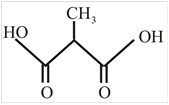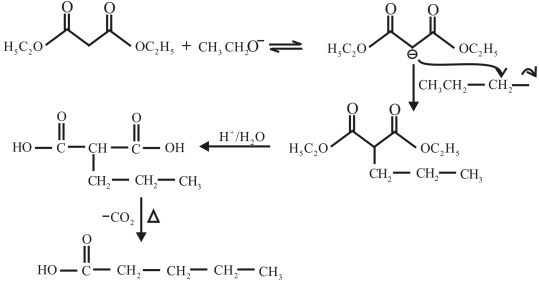
Concept explainers
(a)
Interpretation: The structure of given compounds has to be drawn.
ethylacetoacetate
Concept introduction: The
Carboxylate ion with a carbonyl group at the 3-position loses
(a)
Answer to Problem 48P
The structure of ethyl acetoacetae is,

Explanation of Solution
The name given compound ethyl acetoacetate ends with ate. This means the given compound must contain an ester group. The name of compound starts with ethyl group, this means ethyl group is attached to the oxygen of an ester group. The acetone group is attached with the carbonyl carbon of an ester group. The structure of ethyl acetoacetae is,

(b)
Interpretation: The structure of given compounds has to be drawn.
α-methylmalonicacid
Concept introduction: The
Carboxylate ion with a carbonyl group at the 3-position loses
(b)
Answer to Problem 48P
The structure of α-methylmalonic acid is,

Explanation of Solution
The structure of malonic acid is two

(c)
Interpretation: The structure of given compounds has to be drawn.
β-keto ester
Concept introduction: The
Carboxylate ion with a carbonyl group at the 3-position loses
(c)
Answer to Problem 48P
The structure of β-keto ester is,

Explanation of Solution
The given compound β-keto ester contains a keto group and an ester group. The structure of β-keto ester is,

(d)
Interpretation: The structure of given compounds has to be drawn.
The carboxylic acid obtained from malonic ester synthesis when the
Concept introduction: The
Carboxylate ion with a carbonyl group at the 3-position loses
(d)
Answer to Problem 48P
The structure of enol form of cyclopentanone is,

Explanation of Solution
The compound cyclopentanone contain a keto group. After the keto enol tautomerism the keto compound converted into an alcohol and a double bond. The structure of enol form of cyclopentanone is,

(e)
Interpretation: The structure of given compounds has to be drawn.:
The structure of enol form of cyclopentanone
Concept introduction: The
Carboxylate ion with a carbonyl group at the 3-position loses
(e)
Answer to Problem 48P
The structure of the carboxylic acid obtained from malonic ester synthesis by using propyl bromide is,

Explanation of Solution
The proton removed from the alpha carbon of malonic ester by the base. Then, there is a nucleophilic substitution reaction takes place between the propyl bromide and carbanion of malonic ester. The third step is acidic hydrolysis of an ester to form carboxylic acid. The fourth step is decarboxylation of the compound to form the desired product. The reaction and structure of given compound is,

Want to see more full solutions like this?
Chapter 17 Solutions
Organic Chemistry (8th Edition)
- Using the conditions of spontaneity to deduce the signs of AH and AS Use the observations about each chemical reaction in the table below to decide the sign (positive or negative) of the reaction enthalpy AH and reaction entropy AS. Note: if you have not been given enough information to decide a sign, select the "unknown" option. reaction observations conclusions A The reverse of this reaction is always spontaneous but proceeds faster at temperatures above -48. °C. ΔΗ is (pick one) ✓ AS is (pick one) B This reaction is spontaneous except below 114. °C but proceeds at a slower rate below 135. °C. ΔΗ is (pick one) AS is (pick one) ΔΗ is C This reaction is exothermic and proceeds faster at temperatures above -43. °C. (pick one) AS is (pick one) v Х 5 ? 18 Ararrow_forwardion. A student proposes the following Lewis structure for the perchlorate (CIO) io : :0: : Cl : - - : :0: ك Assign a formal charge to each atom in the student's Lewis structure. atom central O formal charge ☐ top O ☐ right O ☐ bottom O ☐ Cl ☐arrow_forwardDecide whether these proposed Lewis structures are reasonable. proposed Lewis structure Yes. Is the proposed Lewis structure reasonable? Cl- : 2: :Z: :Z: N—N : 0: C C1: O CO No, it has the wrong number of valence electrons. The correct number is: ☐ No, it has the right number of valence electrons but doesn't satisfy the octet rule. The symbols of the problem atoms are:* ☐ Yes. No, it has the wrong number of valence electrons. The correct number is: ☐ No, it has the right number of valence electrons but doesn't satisfy the octet rule. The symbols of the problem atoms are:* | Yes. No, it has the wrong number of valence electrons. The correct number is: No, it has the right number of valence electrons but doesn't satisfy the octet rule. The symbols of the problem atoms are:* | If two or more atoms of the same element don't satisfy the octet rule, just enter the chemical symbol as many times as necessary. For example, if two oxygen atoms don't satisfy the octet rule, enter "0,0". ☑arrow_forward
- Use the observations about each chemical reaction in the table below to decide the sign (positive or negative) of the reaction enthalpy AH and reaction entropy AS. Note: if you have not been given enough information to decide a sign, select the "unknown" option. reaction observations conclusions ΔΗ is (pick one) A This reaction is faster above 103. °C than below. AS is (pick one) ΔΗ is (pick one) B This reaction is spontaneous only above -9. °C. AS is (pick one) ΔΗ is (pick one) C The reverse of this reaction is always spontaneous. AS is (pick one) 18 Ararrow_forwardUse the observations about each chemical reaction in the table below to decide the sign (positive or negative) of the reaction enthalpy AH and reaction entropy AS. Note: if you have not been given enough information to decide a sign, select the "unknown" option. reaction observations conclusions A The reverse of this reaction is always spontaneous but proceeds slower at temperatures below 41. °C. ΔΗ is (pick one) AS is (pick one) ΔΗ is (pick one) B This reaction is spontaneous except above 94. °C. AS is (pick one) This reaction is always spontaneous, but ΔΗ is (pick one) C proceeds slower at temperatures below −14. °C. AS is (pick one) Х 00. 18 Ar 무ㅎ B 1 1arrow_forwardDraw the product of the reaction shown below. Ignore inorganic byproducts. + H CH3CH2OH HCI Drawingarrow_forward
- please explain this in simple termsarrow_forwardK Most Reactive Na (3 pts) Can the metal activity series (shown on the right) or a standard reduction potential table explain why potassium metal can be prepared from the reaction of molten KCI and Na metal but sodium metal is not prepared from the reaction of molten NaCl and K metal? Show how (not). Ca Mg Al с Zn Fe Sn Pb H Cu Ag Au Least Reactivearrow_forward(2 pts) Why is O2 more stable as a diatomic molecule than S2?arrow_forward
- Draw the Lewis structure for the polyatomic phosphite (PO¾³¯) a anion. Be sure to include all resonance structures that satisfy the octet rule. C I A [ ]¯arrow_forwardDecide whether these proposed Lewis structures are reasonable. proposed Lewis structure Is the proposed Lewis structure reasonable? Yes. :0: Cl C C1: 0=0: : 0 : : 0 : H C N No, it has the wrong number of valence electrons. The correct number is: ☐ No, it has the right number of valence electrons but doesn't satisfy the octet rule. The symbols of the problem atoms are:* ☐ Yes. No, it has the wrong number of valence electrons. The correct number is: ☐ No, it has the right number of valence electrons but doesn't satisfy the octet rule. The symbols of the problem atoms are:* Yes. ☐ No, it has the wrong number of valence electrons. The correct number is: ☐ No, it has the right number of valence electrons but doesn't satisfy the octet rule. The symbols of the problem atoms are:* | * If two or more atoms of the same element don't satisfy the octet rule, just enter the chemical symbol as many times as necessary. For example, if two oxygen atoms don't satisfy the octet rule, enter "0,0".arrow_forwardDraw the Lewis structure for the polyatomic trisulfide anion. Be sure to include all resonance structures that satisfy the octet rule. с [ ] - Garrow_forward
 Chemistry for Today: General, Organic, and Bioche...ChemistryISBN:9781305960060Author:Spencer L. Seager, Michael R. Slabaugh, Maren S. HansenPublisher:Cengage Learning
Chemistry for Today: General, Organic, and Bioche...ChemistryISBN:9781305960060Author:Spencer L. Seager, Michael R. Slabaugh, Maren S. HansenPublisher:Cengage Learning
